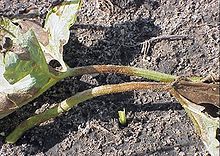
Didymella bryoniae

Didymella bryoniae, syn. Mycosphaerella melonis, is an ascomycete fungal plant pathogen that causes Gummy stem blight on the family Cucurbitaceae . The anamorph/asexual stage for this fungus is called Phoma cucurbitacearum . This pathogen commonly affects the foliage and stems of plants from the family Cucurbitaceae (the family of gords and melons), which includes cantaloupe, cucumber, muskmelon and watermelon plants . When this pathogen infects the fruit of cucurbits it is called black rot . The first symptoms appear as grayish green, circular spots between the veins of the leaf lobes . With age these spots darken to brown and black . Lesions begin to develop on vines at the vine nodes and then elongate into water-soaked streaks, and these streaks are pale brown at first but turn gray with time . Eventually all infected vines will become necrotic and occasionally the plant dies due to wilting and defoliation . Gummy stem blight can be confused with anthracnose, which is caused by a fungal plant pathogen called Colletotrichum lagenarium . To distinguish between anthracnose and gummy stem blight, gummy stem blight leaf lesions are darker, target-like and less deteriorated than anthracnose lesions . In vitro, the fungal growth on an agar plate looks rough and undulated . When grown in vitro on agar, the fungus produces a white to olive-colored mycelium. In latter periods of growth, the mycelium is an olive to dark green or black color . Didymella bryoniae survives on deceased vines, crop debris and on seeds in between seasons and D. bryoniae can survive for 5 months on the soil surface in winter . The fungus develops best under moist conditions and cotyledons and young watermelon/melon leaves are especially susceptible to the fungus . D. bryoniae produces ascospores (meiotic spores) in perithecia and conidia (mitotic spores) in pycnidia and both of these spores are dispersed by rain/rain-splash and UV light is needed in order for the fungus to sporulate . Ideal ascospore dispersal occurs after nightly rainfall and dew periods . In order to infect, ascospores must land on leaves that have free-standing water on them. Next the ascospores penetrate through the leaf cuticle . Stems may be infected by D. bryoniae ascospores through stem wounds or by the extension of leaf lesions . Fruits are penetrated through wounds and pollination flower scars . Conidia are produced on the lesion sites of leaves and stems. Certain Cucurbita species are resistant to D. bryoniae but become vulnerable once they mature . Didymella bryoniae is common in the Southern U.S. and other subtropical or tropical locations . Most infections occur during rainy/wet seasons, in which the humid is greater than 90% and the temperature is roughly 20-24 °C . Humidity seems to be a larger factor than temperature when it comes to infection success . D. bryoniae can also be found in temperate regions, especially where winter squash and pumpkins are grown . This pathogen is also common in greenhouses where cucumbers are grown . In vitro, D. bryoniae does not form pycnidia without UV-light but if cultured in the presence of UV light and darkness, conidia/pycnidiospores produce mycelium rapidly . The standard management practice for D. bryoniae is to use pesticide treated/pathogen-free seeds and to rotate crops on a 2-year cycle to reduce inoculum prevalence . There are no commercially acceptable resistant cucumbers, melons or watermelons available yet on the market, but some plant breeders have identified D. bryoniae resistant genes, such as the gene db in watermelon . Regular benzimidazole fungicide applications can control this pathogen, but certain D. bryoniae isolates have been found to be resistant to benzimidazole fungicides in greenhouse settings and in the field .
